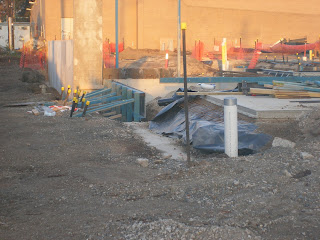The crystal structure was developed by Daniel Libeskind, while its primary structural layout is based on the notion of organically interlocking prismatic forms, the overall structure is composed of a complex steel skeleton, clad with aluminium panels, embacing irrational form given also by glass facade.
It is described as an example of dramatic new architecture.
Initial concept sketch

Construction site from the street - Steel frame, forming structural skeleton




Construction site from above - scafolding, steel framing





Application of aluminium cladding to complex steel frame



External view of the completed 'Crystal' structure

Libeskind's Michael-Lee Crystal envokes curiosity within the viewer to explore its fascinating form of informally entangled skewed geometric forms, both internally and externally.
The internal perception of the crystal structure differs from the viewers perception externally, as the space displays little incorporation of the main external material, the aluminum sheeting. The complex steel skeletal structure is not visable internally, instead the space is filled with false ceilings and non load-bearing partitions, in order to create an entangled journey or experience of its own.
Internal space under construction
 Internal space completed
Internal space completed Computer generated image of the resturant within the 'crystal'
Computer generated image of the resturant within the 'crystal'























